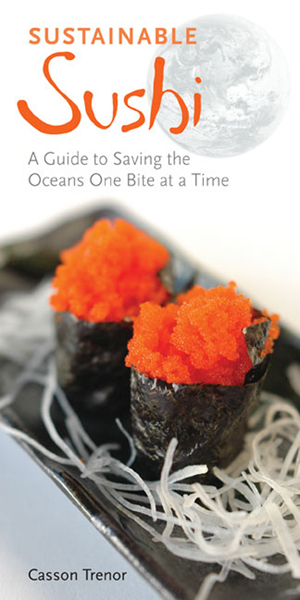Sustainable Sushi

Sit down at your favorite sushi bar to order mirugai, bonito, hotate or akame.
Chances are that you’re not really sure what you’re always eating, given that the seafood names are in Japanese. Moreover, chances are even greater that you’re unsure whether what you’re eating is sustainable or being over-fished to extinction.
You may remember my post last year about three new sustainable sushi guides by three environmental organizations. Now, on the heels of those, comes “Sustainable Sushi” (North Atlantic Books) by Casson Trenor, a sustainable seafood expert who’s also a consultant to Tataki Sake and Sushi Bar in San Francisco, the first sustainable sushi restaurant in North America.

At 110 pages, this book is a more in-depth look at 39 species found on sushi menus. Trenor includes information on such crucial issues as mercury levels, dredging, and crowded fish farms. The species are color-coded so that you can tell from just a glance whether it’s sustainable, unsustainable, or one that you should proceed with caution about. It’s a must-read for any sushi aficionado.
If you’re ever in Seattle, head to Diane’s Market Kitchen for another exercise in sustainable sushi. The cooking school, just blocks from Pike Place Market, hosts a “Sustainable Sushi and Sake” course. The three-and-a-half-hour class teaches you how to make sushi with sustainable seafood, as well as the finer points of sake. Price is $125 per person.
Owner Diane LaVonne is a conservation educator with the Seattle Aquarium.

Hi Carolyn,
Few people really know the facts about the origin of the food and the possible extinction of several fishes, other animals and plants.
Nowadays with a more conscience about the environment I think this book deserve totally a read especially if you’re a sushi fan, like me!
Cheers!
Gera
Thank you for this book recommendation. I’m a huge sushi fan but I definitely have a lot to learn about the subject!
I’m vegetarian so the only sushi I indulge in are veggie rolls, but this book is a great idea nonetheless!
Hello FG,
Very interesting, I wonder how it plays in Japan.
By the way, I want to recommend a blog to you, if you don’t already know it; Foodbeam. She writes and shoots well. Wander through the archive for her feuilettee piece.
Cheers,
Chris (Asheville)
Love the post! I never think about where the fish come from or whether it’s a sustainable fish… for that matter. You really gave me something to think about. I know I will think about this next time I have sushi. Thank you!
It’s true what you all say. I think there is this disconnect with sushi restaurants that there might not be at Western restaurants. At the latter, we scan the menu to make sure we’re not eating farm-raised salmon or over-fished Chilean seabass. But at the former, we just order away, without thinking. Let’s hope that these new guides and books truly give us food for thought.
And Chris, thanks for the tip on Foodbeam.com; Beautiful photos, and amazing pastry-making on that site.
LOVE Casson!!! Isn’t a cutie!?
Seriously first time I read book, I was depressed for a week. All my favorite fish was “red”
bummer
But now that I’ve read the book, and also…Casson KNOWS that I’ve read the book…I’ve just given him permission to slap me silly the next time I order a “red” item.
And now he’s heard you say that, Jaden, so you’d better be on your best behavior…! Oh, and PS — Anna, the whole last section of the book is about vegan and vegetarian options, they’re super important to the sustainability cause. And Carolyn, thank’s so much for the plug! See you at Tataki again sometime soon?
-c
Jaden: I hear ya on that. I was dejected to find out that I shouldn’t be eating unagi because it’s being over-depleted. I LOVE unagi! Sigh. But I love it enough to want it to be around for a long, long time, too.
And Anna, if you ever can make it to Tataki in San Francisco, you’ll be happy to know they offer a lot of vegetarian specialties.
We need some sustainable sushi joints in LA. I’d love to be able to enjoy sushi without worrying about the world’s fish supply and the mercury in my body. I don’t think we have any here, though. At least, I haven’t heard of one.
I’d like to have my sushi without guilt.
Monterey Bay Aquarium has a Sushi list of sustainable sushi fish ingredients. I received a copy of it with my membership but I’m sure they are at the aquarium and perhaps online at their website too.
Pingback: Food Gal » Blog Archiv » San Jose’s Bluefin Restaurant — Where Sharks Gather